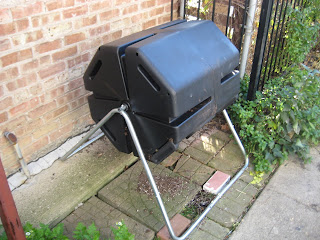
I opened the paper today to the inevitable onslaught of Halloween pumpkin recipes from the classic (pies) to the modern (martinis). I actually don't like many dishes made with pumpkin outside of the usual sweet treats like pies and spice bread, and even then once-a-year is just fine. I favor butternut and kabocha if I'm going to cook with winter squash. For me, they have more flavor and stand up better to aggressive spicing. My friend and I just made a pumpkin layer cake, and the recipe substituted Chinese five-spice for the tradition cinnamon, clove and ginger. The five-spice gave a new dimension to the cake, verging on the savory. I will repeat this substitution with my Thanksgiving pie.
Winter squash is a challenge for the urban gardener: it takes up a lot of space and requires careful watering. Every attempt I have made has ended up like a scene out of some horrible eco-hipster Little Shop of Horrors: the vines grew everywhere, fruiting minimally but invading every corner of the garden, rooting at will and even growing into the siding of the garage. I have seen pictures and read descriptions of growing the squashes vertically, and supporting the heavy growing fruit with netting or even re-purposed pantyhose. This seems a little much for my low-maintenance style of gardening and I suspect even then it is gardener-versus-vine for most of the summer. Fortunately, while we don't have a farmers market in our immediate neighborhood, we do have a family farm truck that shows up once a week from Michigan. This time of year, the pick-up is weighed down with piles of winter squashes. For a dollar, I can pay the farmer directly for a nice, heavy squash and thus avoid the summer nightmare of hacking back insidious squash vines like an Amazonian explorer.
Here is my favorite dish with winter squash, and one that is a real crowd-pleaser. I assume my readers are experienced cooks, so I have not elaborated on the exact process of how to fill the ravioli. I also am using my main concession to the time constraints of my life: wonton skins from the market instead of rolling my own pasta dough. I own a pasta roller, and do make my own pasta once in a while, but I admit that I actually like this recipe better with wonton skins. The filling is so rich and heavy, that the ethereal wrapper seems more appropriate. The pale white eggless dough also shows off the beautiful orange-brown color of the filling.
BUTTERNUT SQUASH RAVIOLI
1 butternut squash
1 tablespoon coriander
1 tablespoon oregano
large pinch fennel seed
large pinch crushed red pepper flakes
1 teaspoon salt
1 teaspoon ground black pepper
2 cloves of garlic, minced or garlic-pressed
1 tablespoon olive oil
1 egg yolk
1/2 cup grated Parmigianno cheese
Wonton skins
4 tablespoons butter
8 sage leaves, torn into pieces
1. Preheat oven to 400. Cut squash lengthwise into 6 skinny wedges, and scoop out seeds. Do not peel.
2. Mash the spices, garlic and oil together in a bowl to make a coarse paste. Rub all over the squash wedges. Place on a baking sheet skin side down and bake until soft, about 45 minutes. Let cool.
3. Scrape out flesh from peel and discard peels. Mash the squash with the egg yolk and a 1/4 cup of the cheese.
4. Put a tablespoon of filling in each wonton skin and seal with water (freeze here if you want -- works great!). Cook in well-salted boiling water 5-7 minutes.
5. Melt butter gently in a small pan and add sage. Allow to infuse for several minutes over low heat. Scoop ravioli from the water and place on a large platter, don't drain too thoroughly, you want some moisture to lighten up the sauce. Pour over the sage butter and turn gently. Sprinkle with remaining cheese.










